Isotope Composition and Chemical Species of Monthly Precipitation Collected at the Site of a Fusion Test Facility in Japan
Abstract
1. Introduction
2. Materials and Methods
2.1. Overview of Study Site
2.2. Sample Collection and Analysis
3. Results and Discussion
3.1. Tritium Concentration in Precipitation
3.2. Stable hydrogen and Oxygen Isotope Composition in Precipitation
3.3. Ion Concentrations in Precipitation
3.4. Environmental Assessment of Impact from the Deuterium Plasma Experiment
4. Conclusions
Author Contributions
Funding
Acknowledgments
Conflicts of Interest
References
- Okada, S.; Momoshima, N. Overview of tritium: Characteristics, sources, and problems. Health Phys. 1993, 65, 595–609. [Google Scholar] [CrossRef] [PubMed]
- United Nations Scientific Committee on the Effects of Atomic Radiation. Sources and Effects of Ionizing Radiation, Volume I: Source; UNSCEAR 2000 Report; Report to the General Assembly, Scientific Annexes; United Nations: New York, NY, USA, 2000. [Google Scholar]
- Canadian Nuclear Safety Commission. Investigation of the Environmental Fate of Tritium in the—Part of the Tritium Studies Projec; INFO0792; Canadian Nuclear Safety Commission: Ottawa, ON, Canada, 2009.
- United Nations Scientific Committee on the Effects of Atomic Radiation. Sources and Effects of Ionizing Radiation; UNSCEAR 2008; Report to General Assembly; Scientific Annexes Volume I; United Nations: New York, NY, USA, 2010. [Google Scholar]
- Schell, W.R.; Sauzay, G.; Payne, B.R. Tritium injection and concentration distribution in the atmosphere. J. Geophys. Res. 1970, 75, 2251–2260. [Google Scholar] [CrossRef]
- Morishima, H.; Kawai, H.; Koga, T.; Niwa, T. The trends of global precipitations. J. Radiat. Res. 1985, 26, 283–312. [Google Scholar] [CrossRef] [PubMed]
- Salonen, L. Carbon-14 and tritium in air in Finland after the Chernobyl accident. Radiochim. Acta 1987, 41, 145–148. [Google Scholar] [CrossRef]
- Matsumoto, T.; Maruoka, T.; Shimoda, G.; Obata, H.; Kagi, H.; Suzuki, K.; Yamamoto, K.; Mitsuguchi, T.; Hagino, K.; Tomioka, N.; et al. Tritium in Japanese precipitation following the March 2011 Fukushima Daiichi Nuclear Plant accident. Sci. Total Environ. 2013, 445-446, 365–370. [Google Scholar] [CrossRef] [PubMed]
- Nakasone, S.; Ishimine, A.; Ishizu, Y.; Shiroma, Y.; Tanaka, M.; Akata, N.; Kakiuchi, H.; Sanada, T.; Furukawa, M. Recent tritium concentration of monthly precipitation in Japan. Radiat. Prot. Dosim. 2019. [Google Scholar] [CrossRef]
- Patel, B.; Campling, D.C.; Macheta, P.; Sandland, K.; Schofield, P.A. Health physics aspects of tritium operation at JET. Fusion Eng. Des. 1999, 47, 267–283. [Google Scholar] [CrossRef]
- Holtkamp, N.; for the ITER Project Team. An overview of the ITER project. Fusion Eng. Des. 2007, 82, 427–434. [Google Scholar] [CrossRef]
- Cristescu, I.R.; Cristescu, I.; Doerr, L.; Glugla, M.; Murdoch, D. Tritium inventories and tritium safety design principles for the fuel cycle of ITER. Nuclear Fusion 2007, 47. [Google Scholar] [CrossRef]
- Stamoulis, K.C.; Karamanis, D.; Ioannides, K.G. Assessment of tritium levels in rivers and precipitation in north-western Greece before the ITER operation. Fusion Eng. Des. 2011, 86, 206–213. [Google Scholar] [CrossRef]
- Takeiri, Y. Advanced helical plasma research towards a steady-state fusion reactor by deuterium experiment in large helical device. Atmos 2018, 6, 69. [Google Scholar] [CrossRef]
- Tanaka, M.; Suzuki, N.; Kato, H.; Kondo, T.; Yokosawa, M.; Kawamata, T.; Ikeda, M.; Meguro, T.; Tanaka, T.; Sonoi, K. Design and commissioning of exhaust detritiation system for the large helical device. Fusion Eng. Des. 2018, 127, 275–283. [Google Scholar] [CrossRef]
- National Institute for Fusion Science. Annual Report for FY 2017 on the Activities of Radiation Safety in LHD Deuterium Plasma Experiment; National Institute for Fusion Science: Toki, Japan, 2018. (In Japanese) [Google Scholar]
- Akata, N.; Kakiuchi, H.; Tamari, T.; Tanaka, M.; Kawano, T.; Miyake, H.; Uda, T.; Nishimura, K. FWT and OBT concentrations in pine needle samples collected at Toki, Japan (1998–2012). Radiat. Prot. Dosim. 2015, 187, 210–214. [Google Scholar] [CrossRef] [PubMed]
- Tanaka, M.; Uda, T. Variation of atmospheric tritium concentration in three chemical forms at Toki, Japan: 2004–12. Radiat. Prot. Dosim. 2015, 187, 187–191. [Google Scholar] [CrossRef] [PubMed]
- Akata, N.; Tanaka, M.; Kato, H.; Yamanishi, H.; Kakiuchi, H.; Hayashi, H.; Miyake, H.; Nishimura, K. Long-term monitoring of tritium concentration in environmental water samples collected at Tono area, Japan. Plasma Fusion Res. 2016, 11, 1305032. [Google Scholar] [CrossRef][Green Version]
- Tanaka, M.; Akata, N.; Iwata, C. Environmental tritium around a fusion test facility, Japan. Radiat. Prot. Dosim. 2019. [Google Scholar] [CrossRef]
- Akata, N.; Hasegawa, H.; Sugihara, S.; Tanaka, M.; Furukawa, M.; Kurita, N.; Kovács, T.; Shiroma, Y.; Kakiuchi, H. Tritium, hydrogen and oxygen isotope compositions in monthly precipitation samples collected at Toki, Japan. Radiat. Prot. Dosim. 2019. [Google Scholar] [CrossRef]
- Japan Meteorological Agency. Automated Meteorological Data AcquistionSystem (AMeDAS). Available online: http://www.data.jma.go.jp/obd/stats/etrn/index.php (accessed on 8 August 2019).
- Akata, N.; Shiroma, Y.; Ikemoto, N.; Kato, A.; Hegedűs, M.; Tanaka, M.; Kakiuchi, H.; Kovács, T. Atmospheric concentration and deposition flux of cosmogenic beryllium-7 at Toki, central part of Japan. Radiat. Environ. Med. 2018, 7, 47–52. [Google Scholar]
- Japan Chemical Analysis Center. Environmental Radioactivity and Radiation in Japan. Available online: http://search.kankyo-hoshano.go.jp (accessed on 8 August 2019).
- Gusyev, M.A.; Morgenstern, U.; Nishihara, T.; Hayashi, T.; Akata, N.; Ichiyanagi, K.; Sugimoto, A.; Hasegawa, A.; Stewart, M.K. Evaluating anthropogenic and environmental tritium effects using precipitation and Hokkaido snowpack at selected coastal locations in Asia. Sci. Total Environ. 2019, 659, 1307–1321. [Google Scholar] [CrossRef]
- Weiss, W.; Roether, W. The rates of tritium input to the world ocean. Earth Planet. Sci. Lett. 1980, 49, 435–446. [Google Scholar] [CrossRef]
- Momoshima, N.; Okai, T.; Kaji, T.; Takashima, Y. Distribution and transformation of various chemical forms of tritium in the environment. Radiochim. Acta 1991, 54, 129–132. [Google Scholar] [CrossRef]
- Akata, N.; Kakiuchi, H.; Shima, N.; Iyogi, T.; Momoshima, N.; Hisamatsu, S. Tritium concentrations in the atmospheric environment at Rokkasho, Japan before the final testing of the spent fuel reprocessing plant. J. Environ. Radioact. 2011, 102, 837–842. [Google Scholar] [CrossRef] [PubMed]
- Lewis, R.R.; Fröhlich, K.; Hebert, D. Contribution to the tritium continental effect. Isot. Environ. Health Stud. 2008, 23, 266–268. [Google Scholar] [CrossRef]
- Araguas-Araguas, L.; Fröehlich, K.; Rozanski, K. Stable isotope composition of precipitation over southeast Asia. J. Geophys. Res. 1998, 103, 28721–28742. [Google Scholar] [CrossRef]
- Craig, H. Isotope variations in meteoric waters. Science 1961, 133, 1702–1703. [Google Scholar] [CrossRef]
- Yabusaki, S. Characteristics of stable isotopes in precipitation at Kumagaya City, Saitama Prefecture. Bull. Geo-Environ. Sci. 2010, 12, 121–125. (In Japanese) [Google Scholar]
- Dansgaard, W. Stable isotopes in precipitation. Tellus 1964, 16, 436–468. [Google Scholar] [CrossRef]
- Waseda, A.; Nakai, N. Isotopic compositions of meteoric and surface waters in Central and Northeast Japan. Chikyukagaku 1983, 17, 83–91. (In Japanese) [Google Scholar]
- Tanoue, M.; Ichiyanagi, K. Deuterium excess in precipitation and water vapor origins over Japan: A review. J. Jpn. Hydrol. Sci. 2016, 46, 101–115. (In Japanese) [Google Scholar]
- Hasegawa, H.; Akata, N.; Kawabata, H.; Sato, T.; Chikuchi, Y.; Hisamatsu, S. Characteristics of hydrogen and oxygen stable isotope ratios in precipitation collected in a snowfall region, Aomori Prefecture, Japan. Geochem. J. 2014, 48, 9–18. [Google Scholar] [CrossRef]
- Ianniello, A.; Spataro, F.; Esposito, I.; Hu, M.; Zhu, T. Chemical characteristics of inorganic ammonium salts in PM2.5 in the atmosphere of Beijing (China). Atmos. Chem. Phys. 2011, 11, 10803–10822. [Google Scholar] [CrossRef]
- Observation Day of Kosa in Gifu Prefecture (1967–2018). Available online: http://www.data.jma.go.jp/gmd/env/kosahp/59chiten/632.html (accessed on 8 August 2019).
- International Commission on Radiological Protection. ICRP Publication 119; Compendium of Dose Coefficients Based on ICRP Publication 60; Elsevier: Amsterdam, The Netherlands, 2011. [Google Scholar]
- World Health Organization. Guidelines for Drinking-Water Quality, Third Edition Incorporating the First and Second Addenda Volume I; Recommendation; WHO: Geneva, Switzerland, 2008. [Google Scholar]
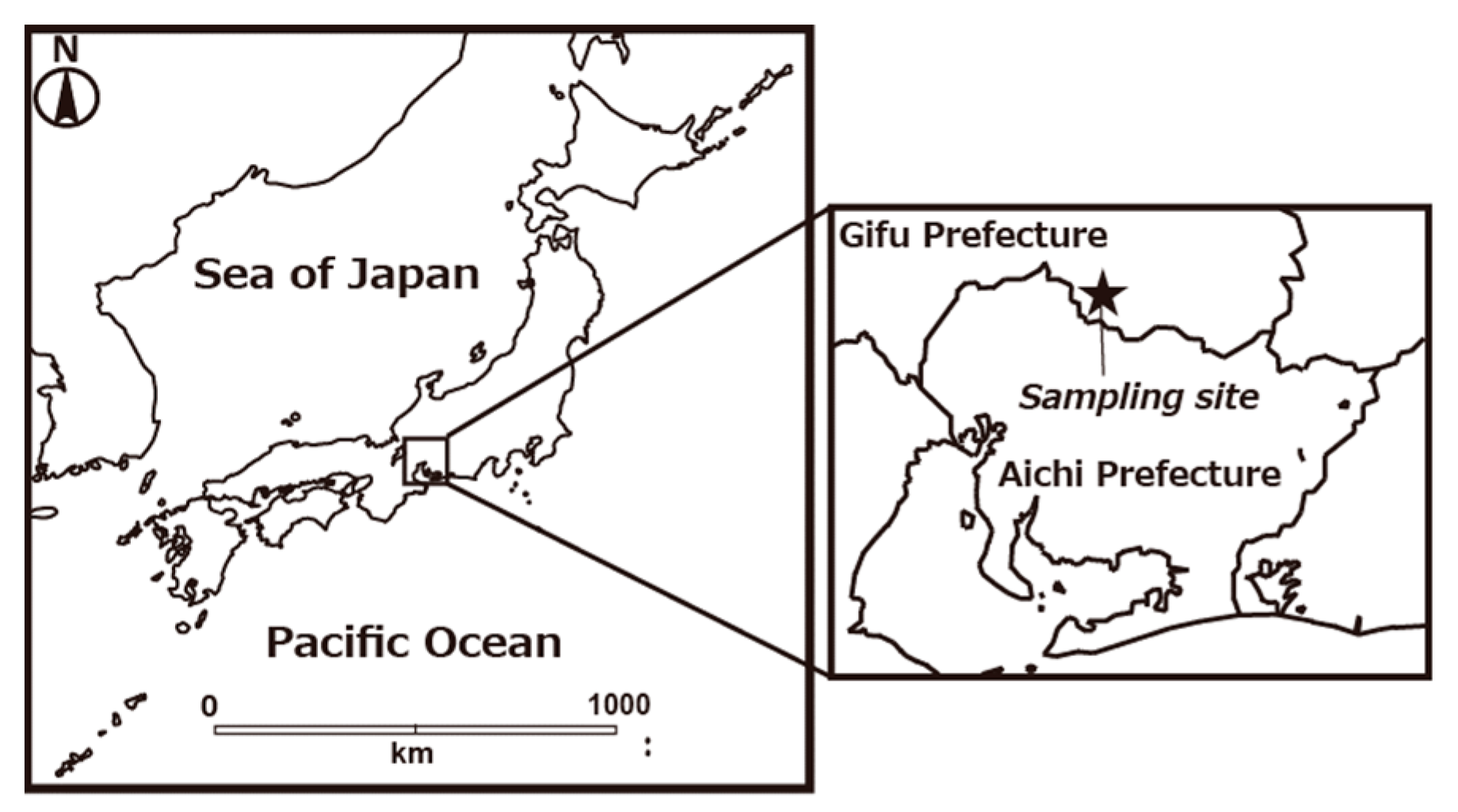

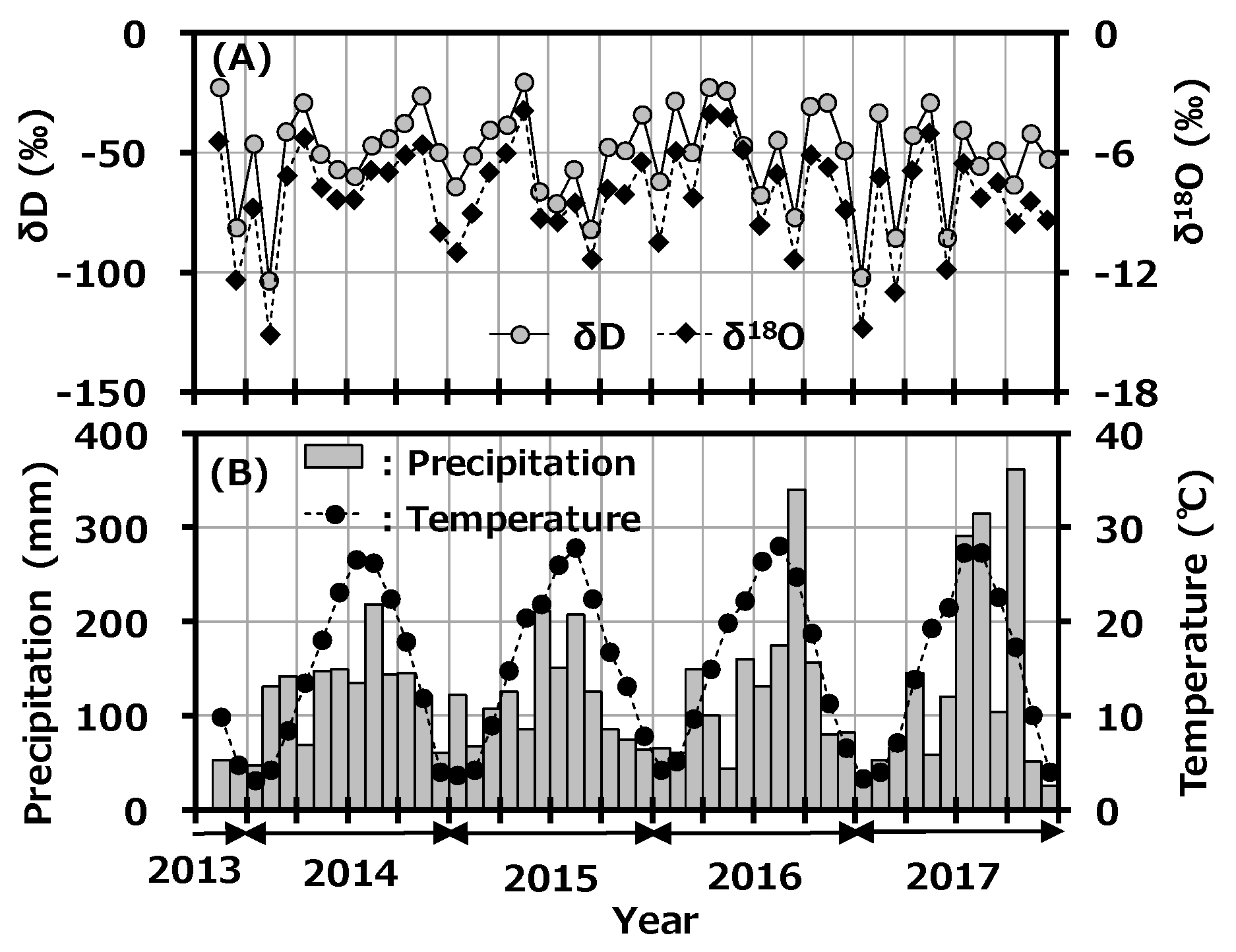

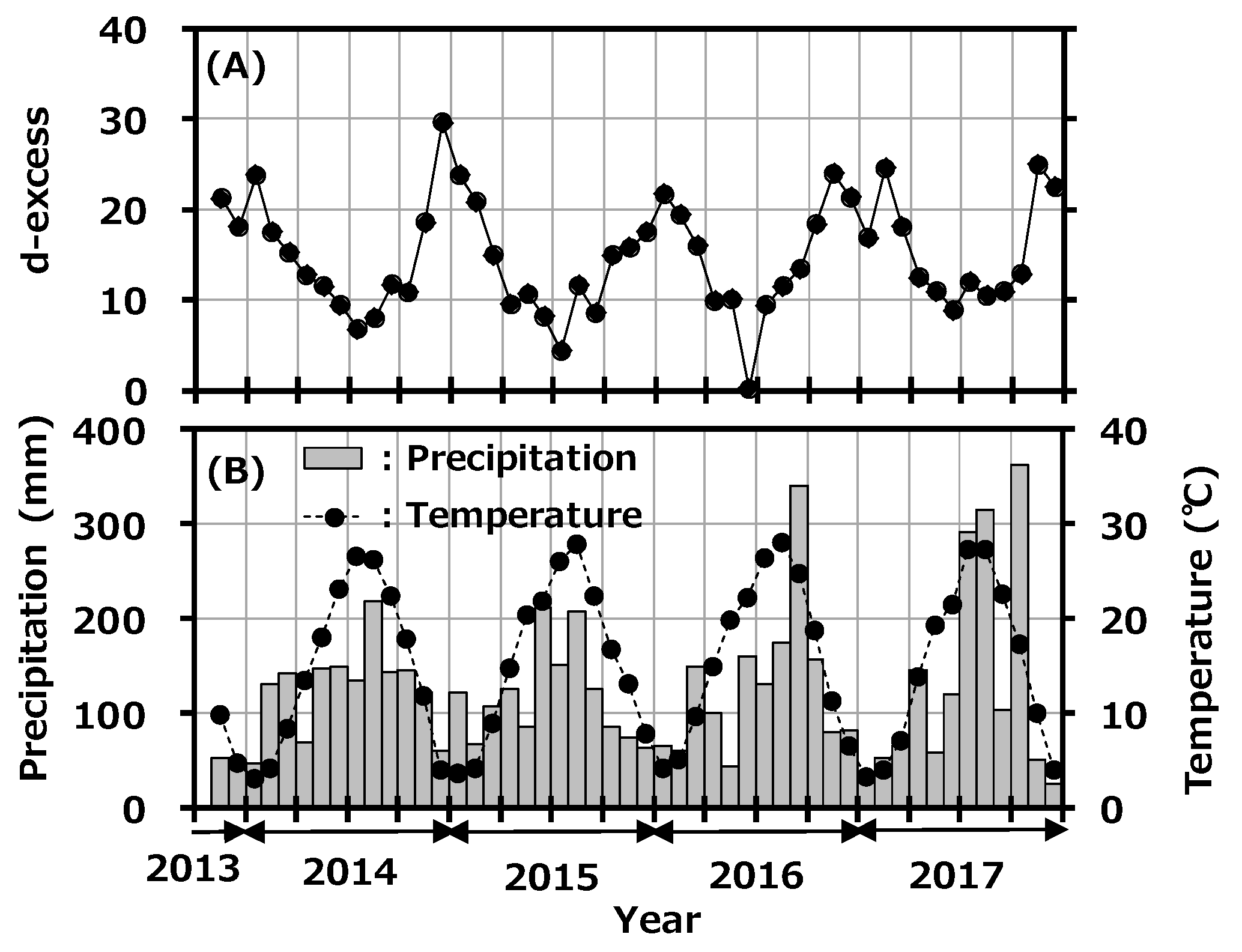
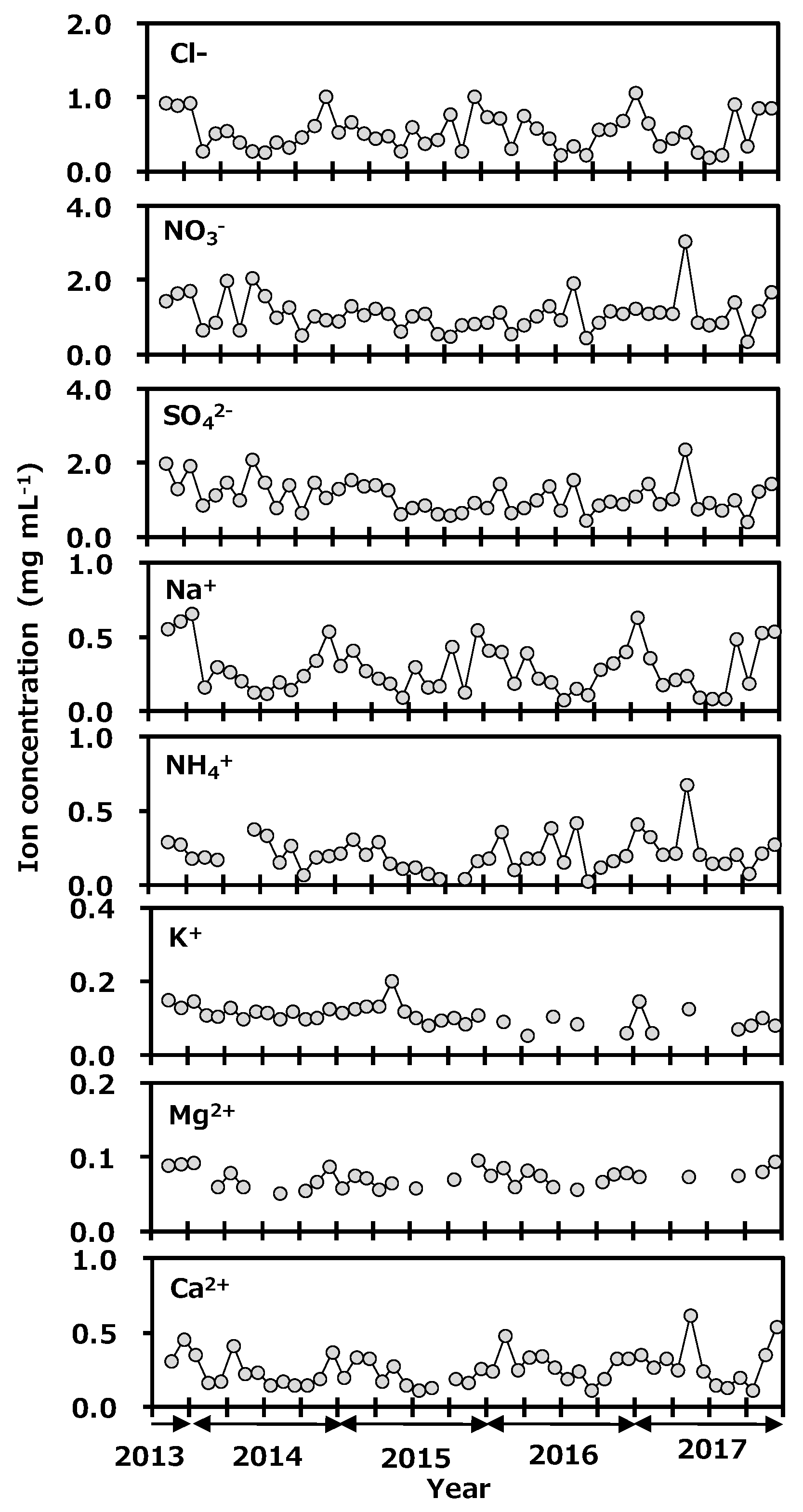
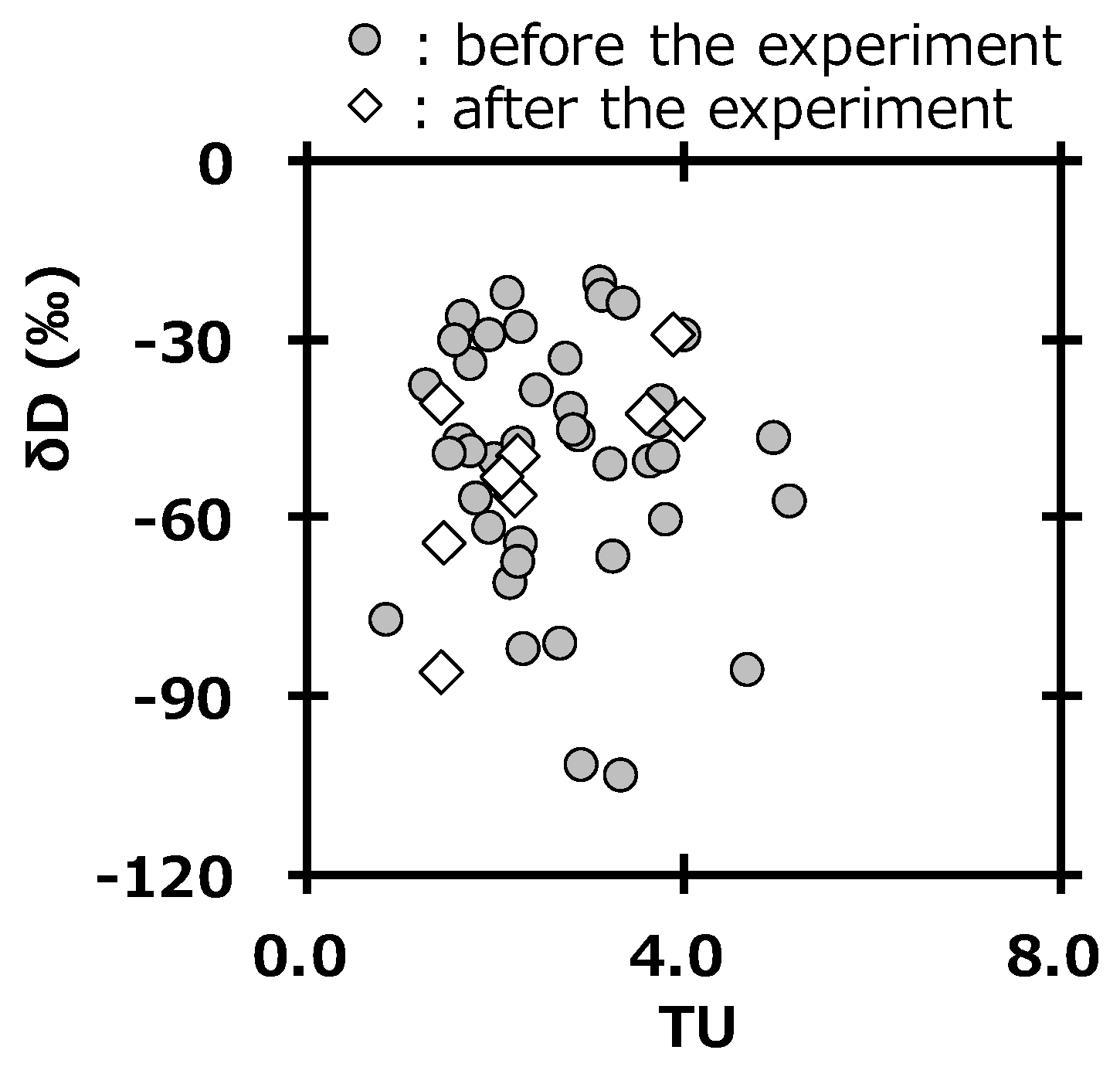
| SO42− | NO3− | Na+ | NH4+ | K+ | Mg2+ | Ca2+ | |
|---|---|---|---|---|---|---|---|
| Cl− | 0.28 | 0.21 | 0.97 | 0.23 | 0.10 | 0.81 | 0.56 |
| SO42− | 0.85 | 0.30 | 0.80 | 0.42 | 0.30 | 0.56 | |
| NO3− | 0.20 | 0.84 | 0.26 | 0.28 | 0.62 | ||
| Na+ | 0.21 | 0.10 | 0.79 | 0.54 | |||
| NH4+ | 0.19 | 0.11 | 0.60 | ||||
| K+ | 0.04 | 0.17 | |||||
| Mg2+ | 0.68 |
© 2019 by the authors. Licensee MDPI, Basel, Switzerland. This article is an open access article distributed under the terms and conditions of the Creative Commons Attribution (CC BY) license (http://creativecommons.org/licenses/by/4.0/).
Share and Cite
Akata, N.; Tanaka, M.; Iwata, C.; Kato, A.; Nakada, M.; Kovács, T.; Kakiuchi, H. Isotope Composition and Chemical Species of Monthly Precipitation Collected at the Site of a Fusion Test Facility in Japan. Int. J. Environ. Res. Public Health 2019, 16, 3883. https://doi.org/10.3390/ijerph16203883
Akata N, Tanaka M, Iwata C, Kato A, Nakada M, Kovács T, Kakiuchi H. Isotope Composition and Chemical Species of Monthly Precipitation Collected at the Site of a Fusion Test Facility in Japan. International Journal of Environmental Research and Public Health. 2019; 16(20):3883. https://doi.org/10.3390/ijerph16203883
Chicago/Turabian StyleAkata, Naofumi, Masahiro Tanaka, Chie Iwata, Akemi Kato, Miki Nakada, Tibor Kovács, and Hideki Kakiuchi. 2019. "Isotope Composition and Chemical Species of Monthly Precipitation Collected at the Site of a Fusion Test Facility in Japan" International Journal of Environmental Research and Public Health 16, no. 20: 3883. https://doi.org/10.3390/ijerph16203883
APA StyleAkata, N., Tanaka, M., Iwata, C., Kato, A., Nakada, M., Kovács, T., & Kakiuchi, H. (2019). Isotope Composition and Chemical Species of Monthly Precipitation Collected at the Site of a Fusion Test Facility in Japan. International Journal of Environmental Research and Public Health, 16(20), 3883. https://doi.org/10.3390/ijerph16203883




